engine Hyundai Genesis 2014 Owner's Manual
[x] Cancel search | Manufacturer: HYUNDAI, Model Year: 2014, Model line: Genesis, Model: Hyundai Genesis 2014Pages: 546, PDF Size: 13.59 MB
Page 533 of 546
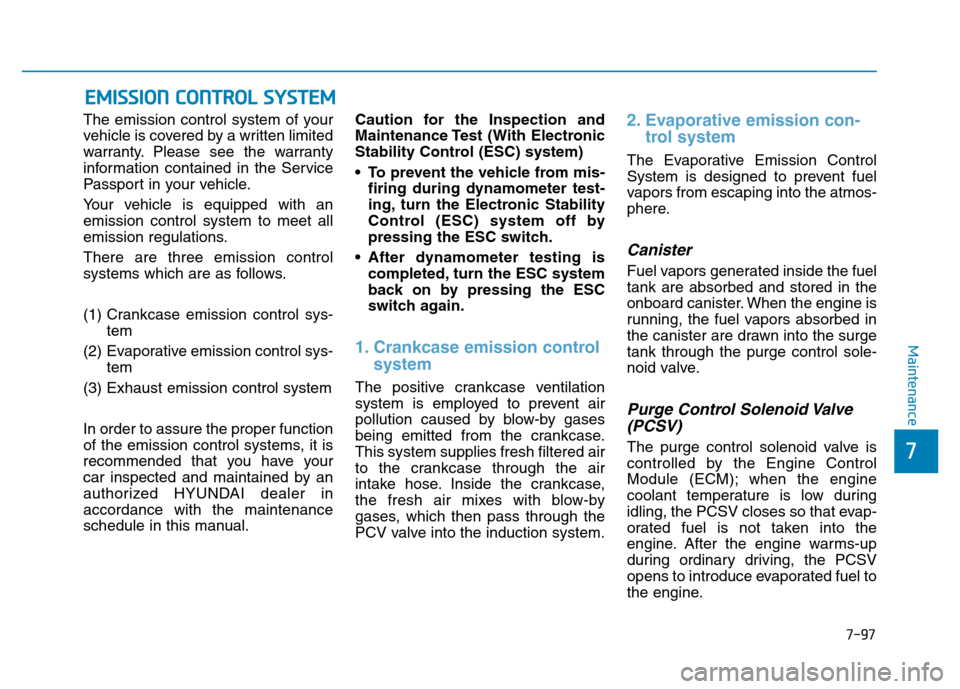
7-97
7
Maintenance
EMISSION CONTROL SYSTEM
The emission control system of your
vehicle is covered by a written limited
warranty. Please see the warranty
information contained in the Service
Passport in your vehicle.
Your vehicle is equipped with an
emission control system to meet all
emission regulations.
There are three emission control
systems which are as follows.
(1) Crankcase emission control sys-
tem
(2) Evaporative emission control sys-
tem
(3) Exhaust emission control system
In order to assure the proper function
of the emission control systems, it is
recommended that you have your
car inspected and maintained by an
authorized HYUNDAI dealer in
accordance with the maintenance
schedule in this manual.Caution for the Inspection and
Maintenance Test (With Electronic
Stability Control (ESC) system)
• To prevent the vehicle from mis-
firing during dynamometer test-
ing, turn the Electronic Stability
Control (ESC) system off by
pressing the ESC switch.
• After dynamometer testing is
completed, turn the ESC system
back on by pressing the ESC
switch again.
1. Crankcase emission control
system
The positive crankcase ventilation
system is employed to prevent air
pollution caused by blow-by gases
being emitted from the crankcase.
This system supplies fresh filtered air
to the crankcase through the air
intake hose. Inside the crankcase,
the fresh air mixes with blow-by
gases, which then pass through the
PCV valve into the induction system.
2. Evaporative emission con-
trol system
The Evaporative Emission Control
System is designed to prevent fuel
vapors from escaping into the atmos-
phere.
Canister
Fuel vapors generated inside the fuel
tank are absorbed and stored in the
onboard canister. When the engine is
running, the fuel vapors absorbed in
the canister are drawn into the surge
tank through the purge control sole-
noid valve.
Purge Control Solenoid Valve
(PCSV)
The purge control solenoid valve is
controlled by the Engine Control
Module (ECM); when the engine
coolant temperature is low during
idling, the PCSV closes so that evap-
orated fuel is not taken into the
engine. After the engine warms-up
during ordinary driving, the PCSV
opens to introduce evaporated fuel to
the engine.
Page 534 of 546
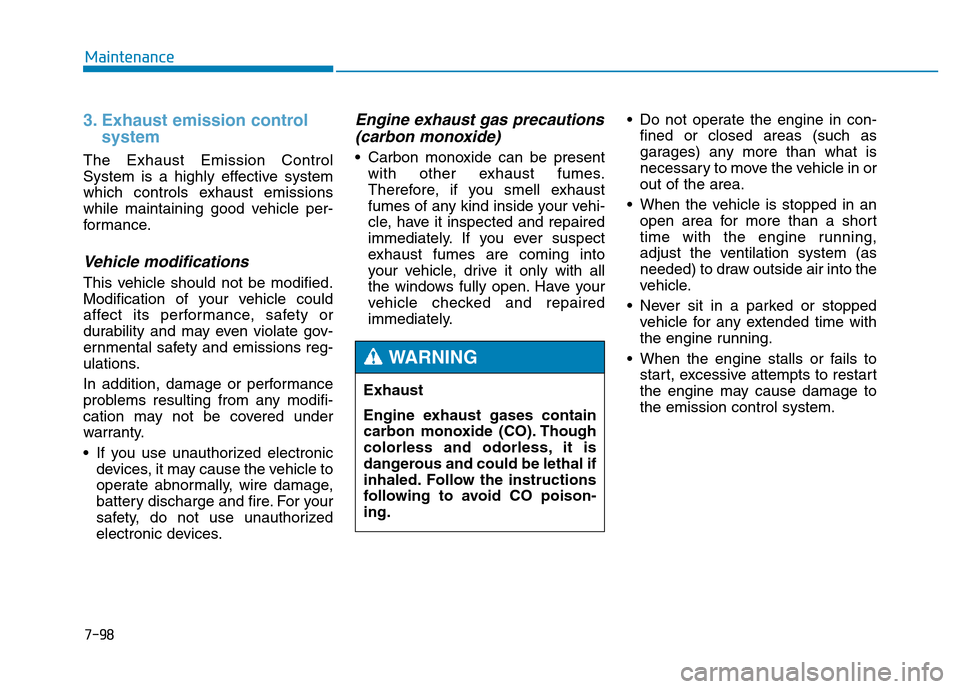
7-98
Maintenance
3. Exhaust emission control
system
The Exhaust Emission Control
System is a highly effective system
which controls exhaust emissions
while maintaining good vehicle per-
formance.
Vehicle modifications
This vehicle should not be modified.
Modification of your vehicle could
affect its performance, safety or
durability and may even violate gov-
ernmental safety and emissions reg-
ulations.
In addition, damage or performance
problems resulting from any modifi-
cation may not be covered under
warranty.
• If you use unauthorized electronic
devices, it may cause the vehicle to
operate abnormally, wire damage,
battery discharge and fire. For your
safety, do not use unauthorized
electronic devices.
Engine exhaust gas precautions
(carbon monoxide)
• Carbon monoxide can be present
with other exhaust fumes.
Therefore, if you smell exhaust
fumes of any kind inside your vehi-
cle, have it inspected and repaired
immediately. If you ever suspect
exhaust fumes are coming into
your vehicle, drive it only with all
the windows fully open. Have your
vehicle checked and repaired
immediately.• Do not operate the engine in con-
fined or closed areas (such as
garages) any more than what is
necessary to move the vehicle in or
out of the area.
• When the vehicle is stopped in an
open area for more than a short
time with the engine running,
adjust the ventilation system (as
needed) to draw outside air into the
vehicle.
• Never sit in a parked or stopped
vehicle for any extended time with
the engine running.
• When the engine stalls or fails to
start, excessive attempts to restart
the engine may cause damage to
the emission control system. Exhaust
Engine exhaust gases contain
carbon monoxide (CO). Though
colorless and odorless, it is
dangerous and could be lethal if
inhaled. Follow the instructions
following to avoid CO poison-
ing.
WARNING
Page 535 of 546
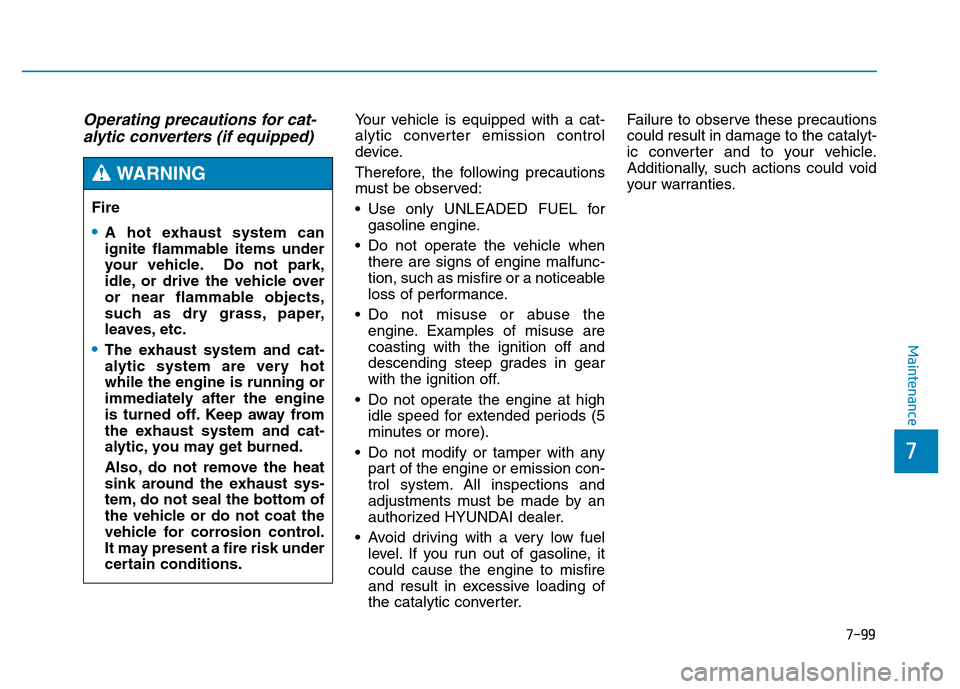
7-99
7
Maintenance
Operating precautions for cat-
alytic converters (if equipped)Your vehicle is equipped with a cat-
alytic converter emission control
device.
Therefore, the following precautions
must be observed:
• Use only UNLEADED FUEL for
gasoline engine.
• Do not operate the vehicle when
there are signs of engine malfunc-
tion, such as misfire or a noticeable
loss of performance.
• Do not misuse or abuse the
engine. Examples of misuse are
coasting with the ignition off and
descending steep grades in gear
with the ignition off.
• Do not operate the engine at high
idle speed for extended periods (5
minutes or more).
• Do not modify or tamper with any
part of the engine or emission con-
trol system. All inspections and
adjustments must be made by an
authorized HYUNDAI dealer.
• Avoid driving with a very low fuel
level. If you run out of gasoline, it
could cause the engine to misfire
and result in excessive loading of
the catalytic converter.Failure to observe these precautions
could result in damage to the catalyt-
ic converter and to your vehicle.
Additionally, such actions could void
your warranties.
Fire
•A hot exhaust system can
ignite flammable items under
your vehicle. Do not park,
idle, or drive the vehicle over
or near flammable objects,
such as dry grass, paper,
leaves, etc.
•The exhaust system and cat-
alytic system are very hot
while the engine is running or
immediately after the engine
is turned off. Keep away from
the exhaust system and cat-
alytic, you may get burned.
Also, do not remove the heat
sink around the exhaust sys-
tem, do not seal the bottom of
the vehicle or do not coat the
vehicle for corrosion control.
It may present a fire risk under
certain conditions.
WARNING
Page 536 of 546
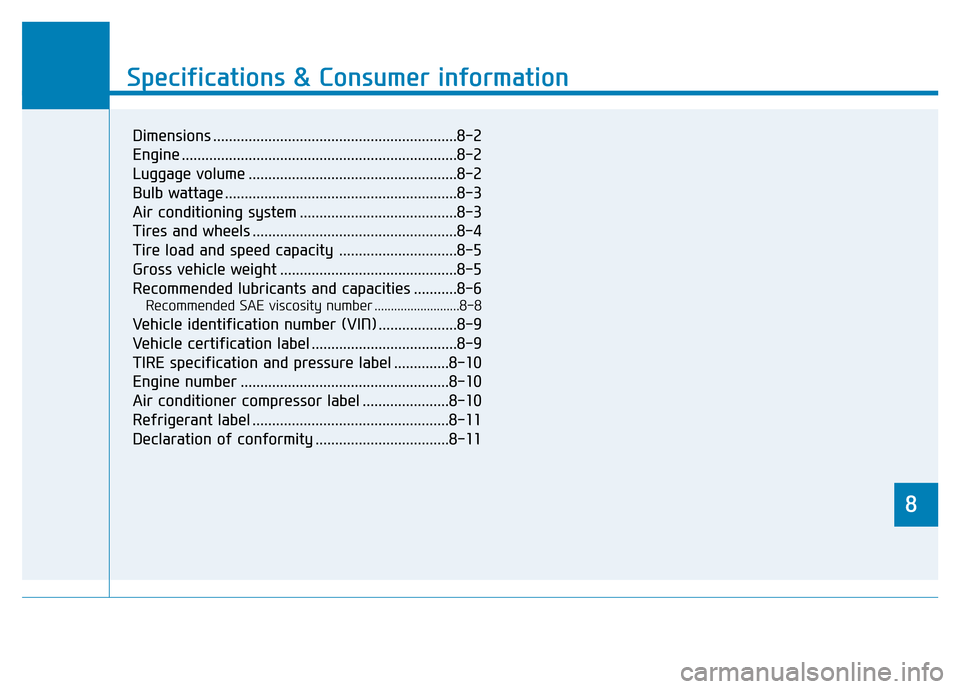
8
Specifications & Consumer information
8
Specifications & Consumer information
8
Dimensions ..............................................................8-2
Engine ......................................................................8-2
Luggage volume .....................................................8-2
Bulb wattage ...........................................................8-3
Air conditioning system ........................................8-3
Tires and wheels ....................................................8-4
Tire load and speed capacity ..............................8-5
Gross vehicle weight .............................................8-5
Recommended lubricants and capacities ...........8-6
Recommended SAE viscosity number ..........................8-8
Vehicle identification number (VIN) ....................8-9
Vehicle certification label .....................................8-9
TIRE specification and pressure label ..............8-10
Engine number .....................................................8-10
Air conditioner compressor label ......................8-10
Refrigerant label ..................................................8-11
Declaration of conformity ..................................8-11
Page 537 of 546
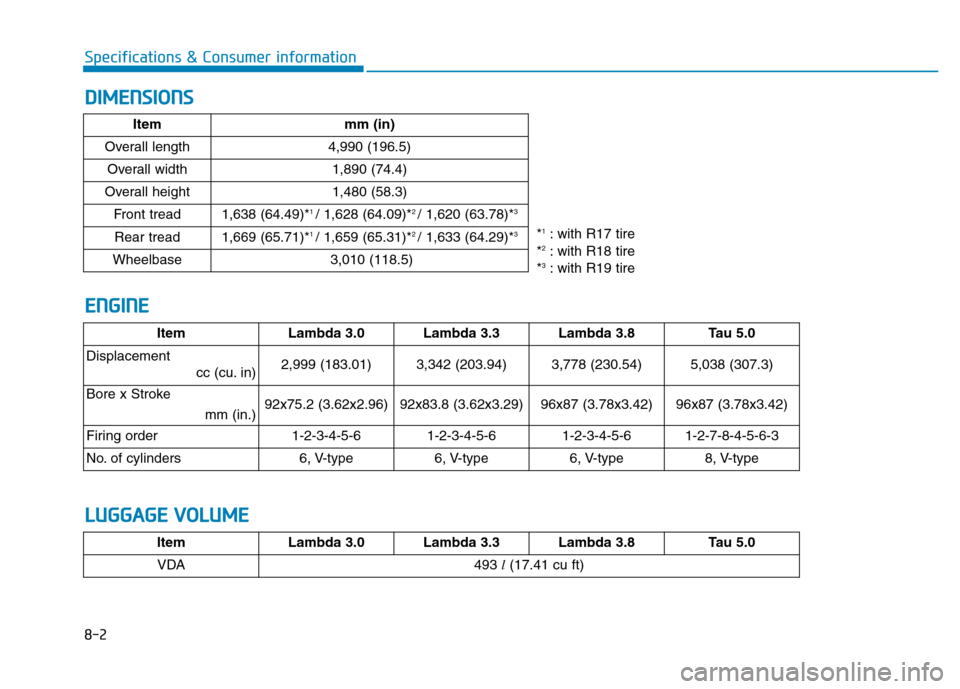
8-2
Specifications & Consumer information
DIMENSIONS
ENGINE
ItemLambda 3.0 Lambda 3.3Lambda 3.8Tau 5.0
Displacement
cc (cu. in)
2,999 (183.01) 3,342 (203.94)3,778 (230.54)5,038 (307.3)
Bore x Stroke
mm (in.)
92x75.2 (3.62x2.96) 92x83.8 (3.62x3.29)96x87 (3.78x3.42)96x87 (3.78x3.42)
Firing order
1-2-3-4-5-6 1-2-3-4-5-61-2-3-4-5-61-2-7-8-4-5-6-3
No. of cylinders
6, V-type 6, V-type6, V-type8, V-type
Item mm (in)
Overall length 4,990 (196.5)
Overall width 1,890 (74.4)
Overall height 1,480 (58.3)
Front tread 1,638 (64.49)*
1 / 1,628 (64.09)*2 / 1,620 (63.78)*3
Rear tread 1,669 (65.71)*1 / 1,659 (65.31)*2 / 1,633 (64.29)*3
Wheelbase 3,010 (118.5)
*1: with R17 tire
*2: with R18 tire
*3: with R19 tire
ltem Lambda 3.0 Lambda 3.3 Lambda 3.8 Tau 5.0
VDA493 l(17.41 cu ft)
LUGGAGE VOLUME
Page 541 of 546
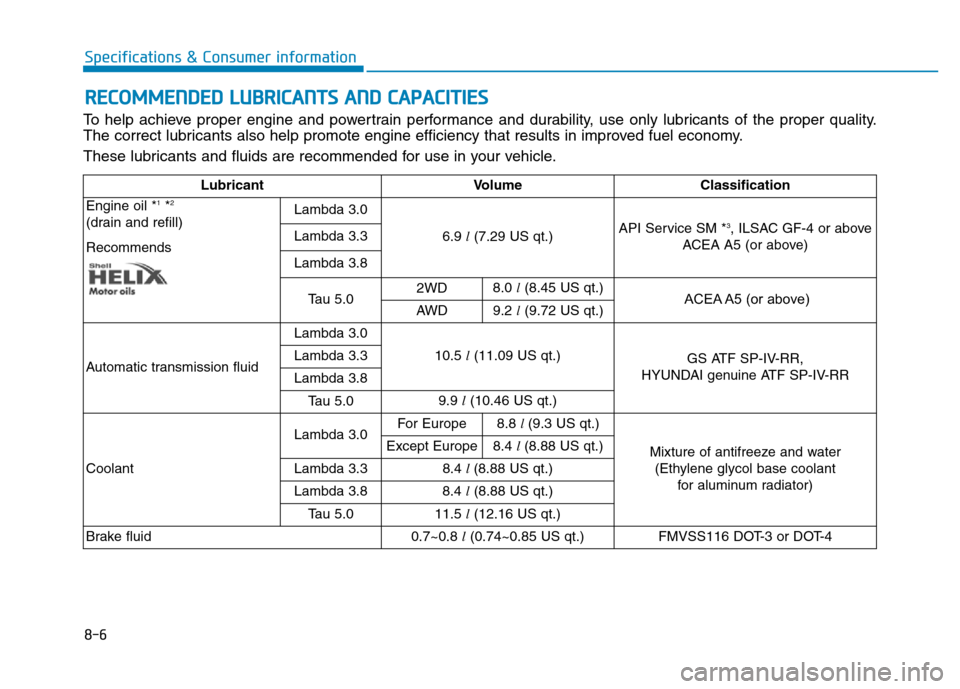
8-6
Specifications & Consumer information
RECOMMENDED LUBRICANTS AND CAPACITIES
To help achieve proper engine and powertrain performance and durability, use only lubricants of the proper quality.
The correct lubricants also help promote engine efficiency that results in improved fuel economy.
These lubricants and fluids are recommended for use in your vehicle.
LubricantVolume Classification
Engine oil *
1*2
(drain and refill)
RecommendsLambda 3.06.9l(7.29 US qt.)API Service SM *3, ILSAC GF-4 or above
ACEA A5 (or above) Lambda 3.3
Lambda 3.8
Tau 5.02WD8.0l(8.45 US qt.)ACEA A5 (or above)AWD9.2l(9.72 US qt.)
Automatic transmission fluidLambda 3.0
10.5l(11.09 US qt.)
GS ATF SP-IV-RR,
HYUNDAI genuine ATF SP-IV-RR Lambda 3.3
Lambda 3.8
Tau 5.09.9l(10.46 US qt.)
Coolant
Lambda 3.0For Europe8.8l (9.3 US qt.)
Mixture of antifreeze and water
(Ethylene glycol base coolant
for aluminum radiator)Except Europe8.4l (8.88 US qt.)
Lambda 3.3
8.4l (8.88 US qt.)
Lambda 3.8
8.4l(8.88 US qt.)
Tau 5.0
11.5l(12.16 US qt.)
Brake fluid0.7~0.8 l(0.74~0.85 US qt.)FMVSS116 DOT-3 or DOT-4
Page 542 of 546
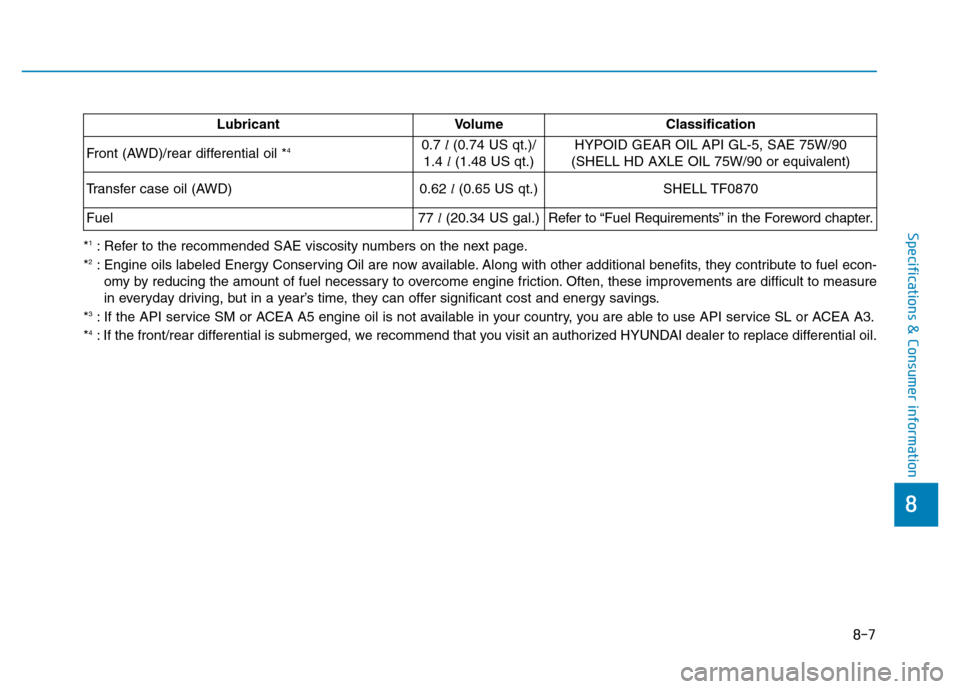
8-7
8
Specifications & Consumer information
*1: Refer to the recommended SAE viscosity numbers on the next page.
*2: Engine oils labeled Energy Conserving Oil are now available. Along with other additional benefits, they contribute to fuel econ-
omy by reducing the amount of fuel necessary to overcome engine friction. Often, these improvements are difficult to measure
in everyday driving, but in a year’s time, they can offer significant cost and energy savings.
*
3: If the API service SM or ACEA A5 engine oil is not available in your country, you are able to use API service SL or ACEA A3.
*4: If the front/rear differential is submerged, we recommend that you visit an authorized HYUNDAI dealer to replace differential oil. Lubricant Volume Classification
Front (AWD)/rear differential oil *
40.7l(0.74 US qt.)/
1.4l(1.48 US qt.)HYPOID GEAR OIL API GL-5, SAE 75W/90
(SHELL HD AXLE OIL 75W/90 or equivalent)
Transfer case oil (AWD) 0.62l(0.65 US qt.)
SHELL TF0870
Fuel77 l(20.34 US gal.)
Refer to “Fuel Requirements” in the Foreword chapter.
Page 543 of 546
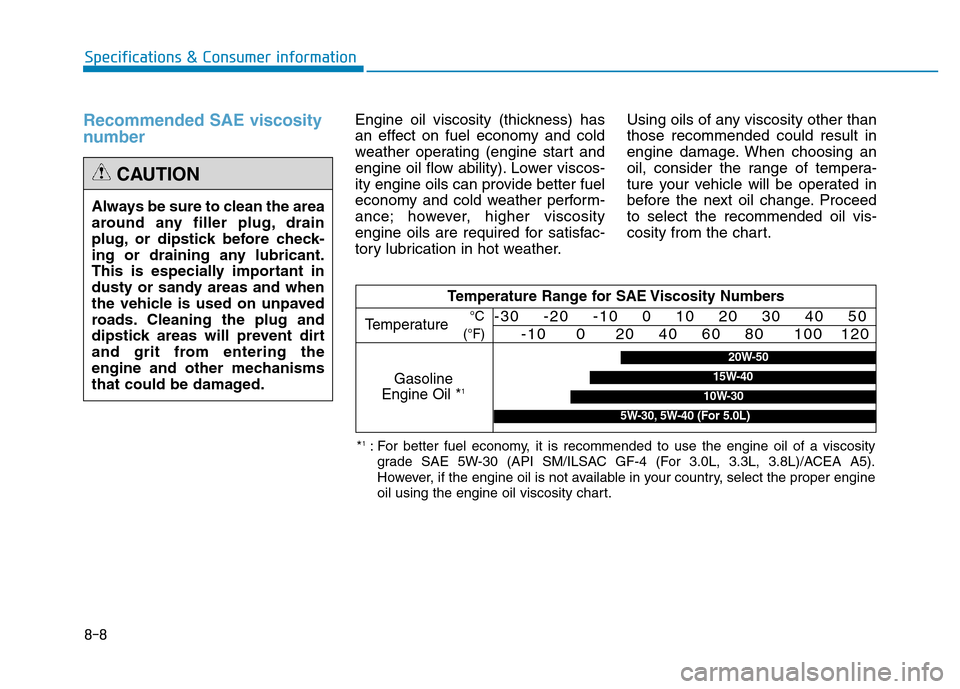
8-8
Specifications & Consumer information
Recommended SAE viscosity
number Engine oil viscosity (thickness) has
an effect on fuel economy and cold
weather operating (engine start and
engine oil flow ability). Lower viscos-
ity engine oils can provide better fuel
economy and cold weather perform-
ance; however, higher viscosity
engine oils are required for satisfac-
tory lubrication in hot weather.Using oils of any viscosity other than
those recommended could result in
engine damage. When choosing an
oil, consider the range of tempera-
ture your vehicle will be operated in
before the next oil change. Proceed
to select the recommended oil vis-
cosity from the chart. Always be sure to clean the area
around any filler plug, drain
plug, or dipstick before check-
ing or draining any lubricant.
This is especially important in
dusty or sandy areas and when
the vehicle is used on unpaved
roads. Cleaning the plug and
dipstick areas will prevent dirt
and grit from entering the
engine and other mechanisms
that could be damaged.
CAUTION
Temperature Range for SAE Viscosity Numbers
Temperature
Gasoline
Engine Oil *
1
°C
(°F)-30 -20 -10 0 10 20 30 40 50
-10 0 20 40 60 80 100 120
20W-50
10W-30
15W-40
5W-30, 5W-40 (For 5.0L)
*1: For better fuel economy, it is recommended to use the engine oil of a viscosity
grade SAE 5W-30 (API SM/ILSAC GF-4 (For 3.0L, 3.3L, 3.8L)/ACEA A5).
However, if the engine oil is not available in your country, select the proper engine
oil using the engine oil viscosity chart.
Page 545 of 546
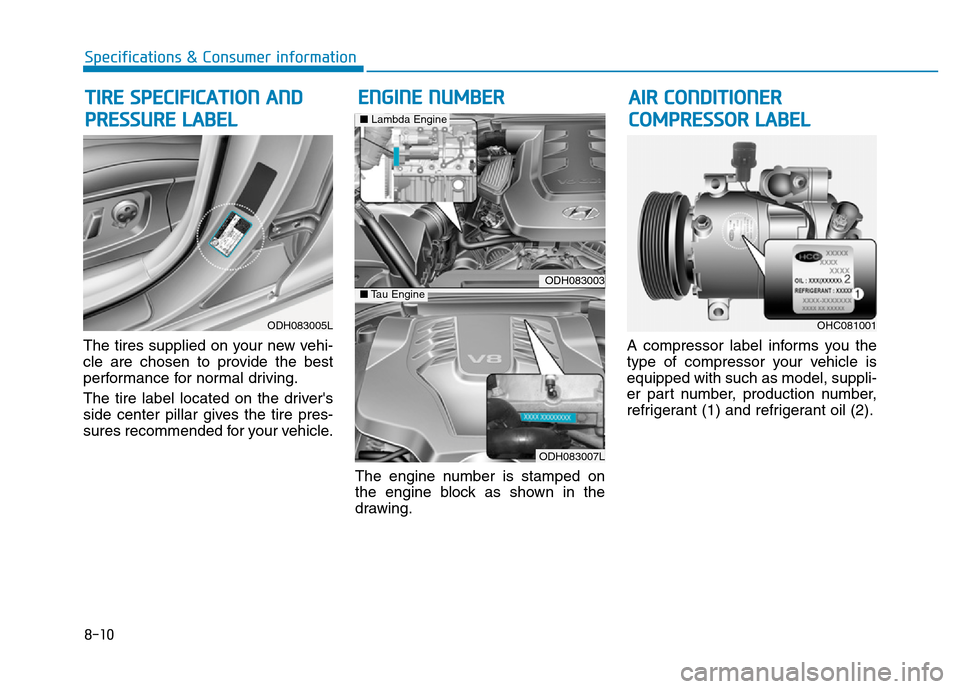
8-10
Specifications & Consumer information
The tires supplied on your new vehi-
cle are chosen to provide the best
performance for normal driving.
The tire label located on the driver's
side center pillar gives the tire pres-
sures recommended for your vehicle.
The engine number is stamped on
the engine block as shown in the
drawing.A compressor label informs you the
type of compressor your vehicle is
equipped with such as model, suppli-
er part number, production number,
refrigerant (1) and refrigerant oil (2).
TIRE SPECIFICATION AND
PRESSURE LABELENGINE NUMBER
ODH083005L
ODH083003
ODH083007L
■Lambda Engine
■Tau Engine
OHC081001
AIR CONDITIONER
COMPRESSOR LABEL
Page 546 of 546
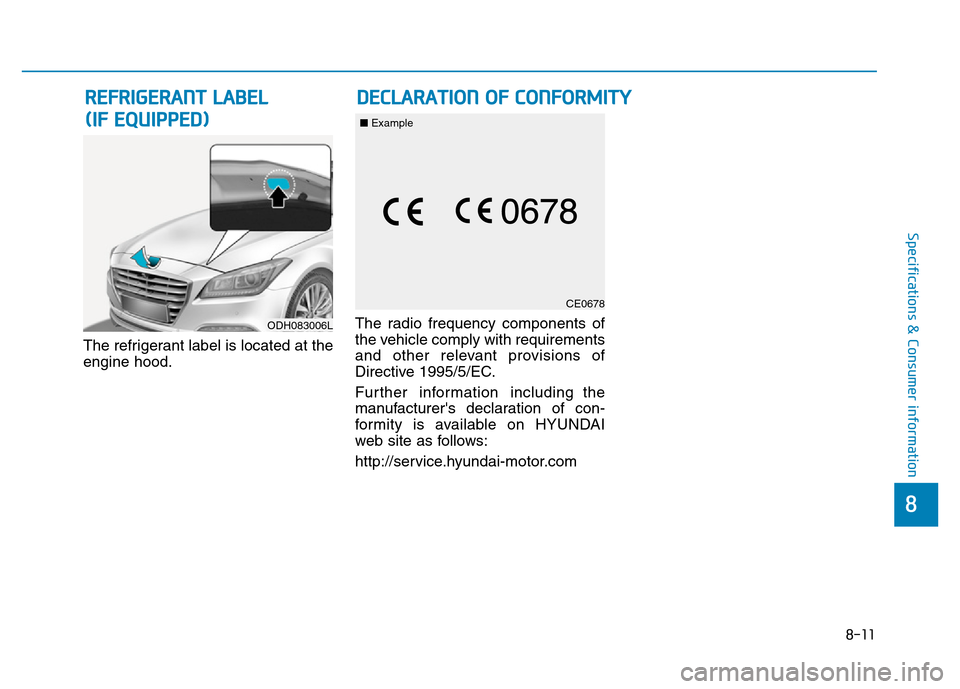
8-11
8
Specifications & Consumer information
The refrigerant label is located at the
engine hood.The radio frequency components of
the vehicle comply with requirements
and other relevant provisions of
Directive 1995/5/EC.
Further information including the
manufacturer's declaration of con-
formity is available on HYUNDAI
web site as follows:
http://service.hyundai-motor.com
ODH083006L
CE0678
REFRIGERANT LABEL
(IF EQUIPPED)DECLARATION OF CONFORMITY
■Example